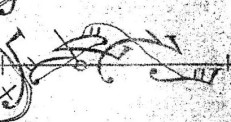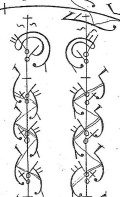The ‘Passagalia of Venüs & Adonis’ was choreographed by Anthony L’Abbé for Drury Lane’s (and London’s) leading dancer Hester Santlow. It was published in notation around 1725 in his A New Collection of Dances. It is the female counterpart to the ‘Chacone of Amadis’ for Louis Dupré who, like Mrs Santlow, has four dances in the collection. We do not know where or when she performed this solo, although I have wondered whether the ‘Passagalia’ might have been created for performance before George I at the Hampton Court Theatre. During September and October 1718, the Drury Lane Company (including Hester Santlow) gave seven performances there, some of which included ‘Entertainments of Dancing’ which were later repeated at their own theatre. Mrs Santlow was a favourite performer of the King and it would surely be appropriate for the royal dancing master to create a new choreography for her to dance before him.
I have myself performed the ‘Passagalia of Venüs & Adonis’ many times and I have also written about it. Returning to this dance after quite a while, partly for the purpose of writing this post, it still amazes me. It isn’t the longest of the surviving notated dances – that honour goes to Pecour’s ‘Passacaille pour une femme’ created for Mlle Subligny to music from Gatti’s Scylla and published in 1704 (with 219 bars of music it is 10 bars longer than L’Abbé’s ‘Passagalia’). Nor is it the best known – it cannot compete with Pecour’s ‘Passacaille pour une femme … de lopera darmide’ again created for Mlle Subligny and published around 1713 in the Nouveau recüeil de dance de bal et celle de ballet. The latter is regularly performed by specialists in baroque dance and has attracted analysis by a number of scholars.
Here, I am concerned only with the pas battus in L’Abbé’s solo, which is to music from Desmarest’s 1697 opera Vénus et Adonis. Unusually for a passacaille, this has a central 80-bar section in duple time framed by tripe-time sections of 64 and 65 bars respectively. The music provides the basis for a choreography that is richly expressive, but my focus is simply on what the notation might tell us about the technique of a leading female professional dancer at this period.
In a post of almost exactly a year ago, I looked at the jetté ‘emböetté’ and asked whether it might usually have been performed by women on stage as a demie cabriole. This step turns up several times in the ‘Passagalia’. It features in the very first variation of the dance (bar 4, plate 46) in a variant form at the beginning of a pas composé and is used, again as the first element of a pas composé, within a short passage in which Mrs Santlow travels rapidly downstage (bars 34-35, plate 48). The density of the notation makes the second of these difficult to show, but here is the first.

Another instance on plate 48 (bar 40) presents a puzzle, for at some point the notation was amended. In the British Library copy, it looks like this.

In the Bodleian Library copy, it looks like this.

In the second version, Mrs Santlow takes off from both feet and a pas battu is clearly notated. There are several small differences between the notations in these two copies. It is difficult to be certain, but these differences suggest that the Bodleian copy is a later issue than that in the British Library.
The jetté-step sequence also turns up in the duple-time section, within a repeated sequence in which the pas composé it begins alternates with another (coupé – pas plié). This is repeated three times and here is the second occurrence (bars 92-93, plate 51).

It is also inserted into pas composés which alternate with chassés as Mrs Santlow retreats upstage (bars 122-125, plate 52). In this case, each pas composé is different – bars 122-123 are shown first, followed by bars 124-125.


In the final triple-time section, L’Abbé plays with a similar idea (in this section, the music has the feel of duple-time). Here are the concluding bars of the sequence (bars 187-188, plate 55).

He uses the jetté-step again as the dance draws to a conclusion (bars 206-207, plate 56).

These are the last steps in which Mrs Santlow advances, before she makes her final retreat to end the solo.
There is no question that Hester Santlow could have performed any, or all, of these steps as demies cabrioles. There are just two more steps that I wish to draw attention to within this complex and surprising choreography. One is the demi entre-chat within the first triple-time section, which begins a pas composé which continues with a coupé to plié and a coupé battu avec ouverture de jambe (bar 50, plate 49).

The other is that quintessentially male step the demie cabriole en tournant un tour en saut de basque within the duple-time section (bar 129, plate 52).

Mrs Santlow does only a half-turn in the air (Feuillet notated it with a three-quarter turn followed by a quarter-turn on the concluding step), but she does perform a pas cabriolé.
The ‘Passagalia of Venüs & Adonis’ is an exceptionally demanding solo – because of its length, the complexity of its steps (there are no exactly repeated variations), its changes in time signature and its expressivity. For me, it signals very clearly that the leading female professional dancers of the early 18th century were fully the equals of their male partners when it came to pas battus.
























